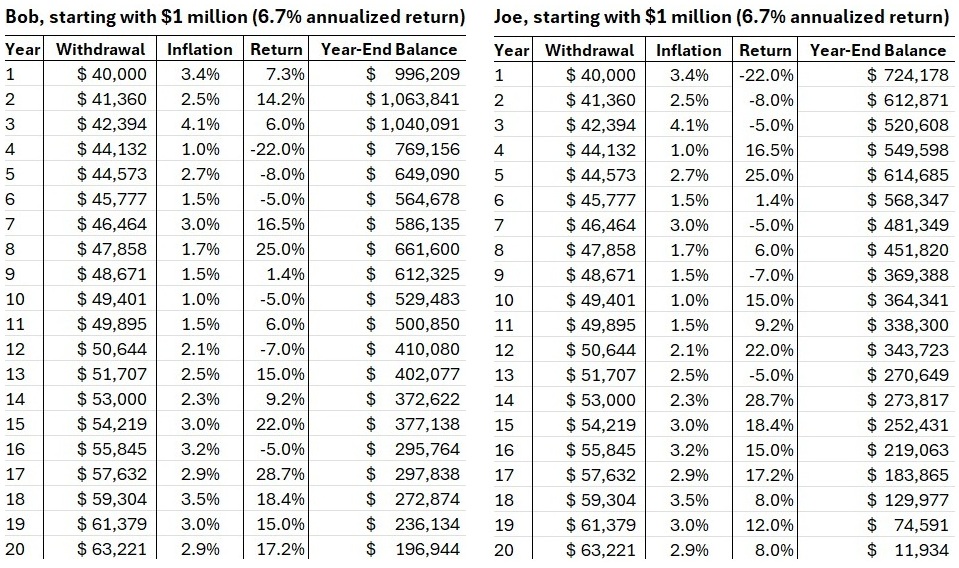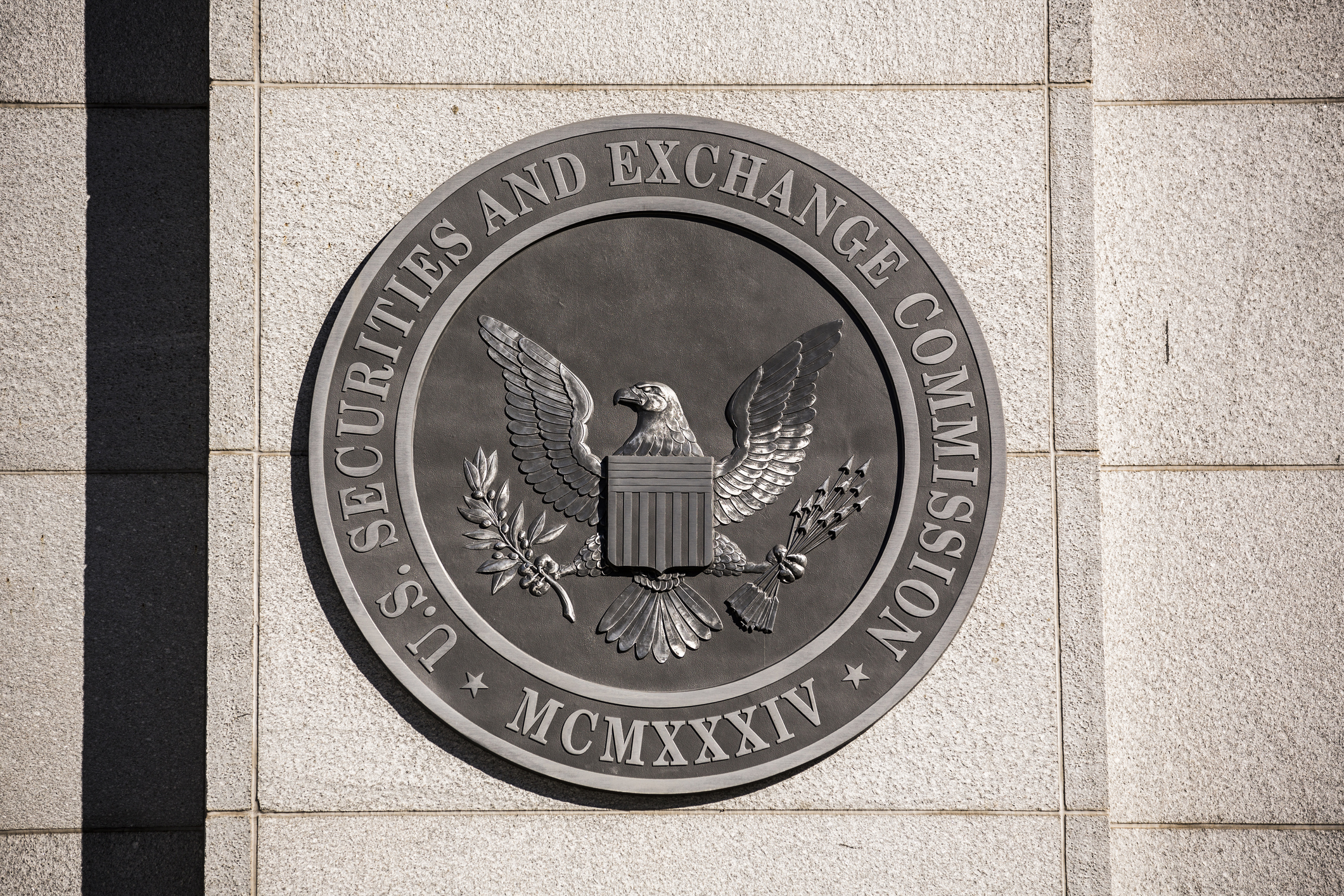A Retirement Plan Isn't Just a Number: Strategic Withdrawals Can Make a Huge Difference
A major reason not to set your retirement plan on autopilot: sequence of returns risk. A flexible strategy with cash reserves and smart withdrawal moves can help ensure that a bad market doesn't sink your golden years.


Here's a startling truth: Two retirees with identical portfolios and withdrawal rates could experience the same average annual return and end up with vastly different outcomes.
In the worst-case scenario, one might run out of money, while the other sails through retirement comfortably.
This isn't a coincidence; it's a critical retirement threat known as sequence of returns risk.
From just $107.88 $24.99 for Kiplinger Personal Finance
Become a smarter, better informed investor. Subscribe from just $107.88 $24.99, plus get up to 4 Special Issues

Sign up for Kiplinger’s Free Newsletters
Profit and prosper with the best of expert advice on investing, taxes, retirement, personal finance and more - straight to your e-mail.
Profit and prosper with the best of expert advice - straight to your e-mail.
Kiplinger's Adviser Intel, formerly known as Building Wealth, is a curated network of trusted financial professionals who share expert insights on wealth building and preservation. Contributors, including fiduciary financial planners, wealth managers, CEOs and attorneys, provide actionable advice about retirement planning, estate planning, tax strategies and more. Experts are invited to contribute and do not pay to be included, so you can trust their advice is honest and valuable.
The problem with 'average' returns
Most investors know that the S&P 500 has averaged gains of about 10% a year in the long term, but that smooth average hides a bumpy road.
For instance, from 1995 to 2024, the S&P 500's annualized return was 10.9%. However, in only two of those 30 years did the market's return fall within two percentage points of that average.
This volatility is a minor concern during your working years when you're accumulating assets. But as you transition from a paycheck to living off your investments, market declines — especially early in retirement — can be devastating.
Consider the tale of two retirees, Bob and Joe. Both started with a $1 million portfolio and followed the same 4% withdrawal rule, adjusted for inflation.
- Bob experienced a "favorable" sequence of returns, and after 20 years, he had more than $196,000 remaining in his portfolio.
- Joe, however, experienced a "negative" sequence, with losses in the first three years of his retirement. Despite the same annualized return over the full period, Joe ran out of money in year 21.
Here's how 20 years unfolded in both cases:

Beyond the Monte Carlo simulation
Many advisers use tools such as the Monte Carlo simulations to illustrate the range of possible outcomes, but a simulation is not a plan. It's a single dashboard indicator, such as the speedometer on your car.
A true retirement plan is a dynamic strategy that requires continuous monitoring and adjustments.
Think of it as a football game. Good coaches don't just stick to the playbook; they make proactive adjustments based on the score, weather, injuries and the opponent's strategy.
Your retirement is the same. The rules of the game — the tax code, market conditions and your personal situation — are always changing. A flexible plan is your best defense.
Here's how you can reduce the sequence of returns risk:
Build a cash reserve. We advise clients to have 18 to 24 months of expected living expenses in cash or cash equivalents at the start of retirement. During a market downturn, you can draw from this reserve instead of selling portfolio assets at a loss.
In our earlier example, if Joe had forgone portfolio withdrawals during his first two years of losses, his outcome would have been completely different.
Use a reasonable, flexible withdrawal rate. Many retirees are familiar with the 4% rule, formulated based on research by Bill Bengen in the early 1990s. This rule states that you can take 4% of the initial portfolio value and adjust your annual withdrawals by inflation each year.
Bengen's initial research looked at 39 30-year periods covering 1926 to 1993 and had a 100% success rate using a 50/50 asset allocation. Bengen's latest research suggests a slightly higher sustainable withdrawal rate of around 4.7%.
Looking for expert tips to grow and preserve your wealth? Sign up for Adviser Intel (formerly known as Building Wealth), our free, twice-weekly newsletter.
However, we often see clients use a fluctuating rate. For example, a retiree who delays Social Security until age 70 might withdraw a bit more in the early years of retirement, then drop their withdrawal rate once Social Security benefits begin.
Implement an efficient withdrawal strategy. A smart plan is about more than just a percentage. It's about drawing from the right assets, in the right accounts, in the right order. This means:
- Selling winners, not losers: When you need to raise cash, you can sell from asset classes that have performed well to avoid selling at a loss.
- Strategic tax planning: Tax laws change, and a good plan adapts. Recent tax changes, such as the enhanced deduction for people who are 65 and older, might make it more tax-efficient to draw more from your IRA than from a taxable account.
Sequence of returns risk is a very real challenge, but it's not insurmountable. The good news is that with a solid plan, you can significantly reduce its impact.
When it comes to retirement planning, a "set-it-and-forget-it" strategy is unlikely to work. It requires a disciplined process and continuous monitoring.
A good financial adviser acts as your financial coach, helping you make smart, informed decisions so you can navigate the bumps in the road and enjoy a secure, confident retirement.
Related Content
- Sequence of Return Risk: How Retirees Can Protect Themselves
- I'm a Financial Planner: How to Dodge a Retirement Danger You May Not Have Heard About
- Don't Let Sequence of Returns Risk Cook Your Goose
- Three Ways to Protect Your Retirement From Sequence of Returns Risk
Profit and prosper with the best of Kiplinger's advice on investing, taxes, retirement, personal finance and much more. Delivered daily. Enter your email in the box and click Sign Me Up.

Mike Palmer has over 25 years of experience helping successful people make smart decisions about money. He is a graduate of the University of North Carolina at Chapel Hill and is a CERTIFIED FINANCIAL PLANNER™ professional. Mr. Palmer is a member of several professional organizations, including the National Association of Personal Financial Advisors (NAPFA) and past member of the TIAA-CREF Board of Advisors.
-
 Introducing Your CD's Edgier Cousin: The Market-Linked CD
Introducing Your CD's Edgier Cousin: The Market-Linked CDTraditional CDs are a safe option for savers, but they don't always beat inflation. Should you try their counterparts, market-linked CDs, for better returns?
-
 'Humbug!' Say Consumers, Despite Hot GDP: Stock Market Today
'Humbug!' Say Consumers, Despite Hot GDP: Stock Market Today"The stock market is not the economy," they say, but both things are up. Yet one survey says people are still feeling down in the middle of this complex season.
-
 The SEC Is Concerned for Older Investors and Retirement Savers. Here's What You Should Know
The SEC Is Concerned for Older Investors and Retirement Savers. Here's What You Should KnowThe SEC focusing on older investors, retirement and college savers, and private securities. Here's how those changes impact you.
-
 Introducing Your CD's Edgier Cousin: The Market-Linked CD
Introducing Your CD's Edgier Cousin: The Market-Linked CDTraditional CDs are a safe option for savers, but they don't always beat inflation. Should you try their counterparts, market-linked CDs, for better returns?
-
 'Humbug!' Say Consumers, Despite Hot GDP: Stock Market Today
'Humbug!' Say Consumers, Despite Hot GDP: Stock Market Today"The stock market is not the economy," they say, but both things are up. Yet one survey says people are still feeling down in the middle of this complex season.
-
 The SEC Is Concerned for Older Investors and Retirement Savers. Here's What You Should Know.
The SEC Is Concerned for Older Investors and Retirement Savers. Here's What You Should Know.The SEC focusing on older investors, retirement and college savers, and private securities. Here's how those changes impact you.
-
 Vesting, Catch-Ups and Roths: The 401(k) Knowledge Quiz
Vesting, Catch-Ups and Roths: The 401(k) Knowledge QuizQuiz Test your understanding of key 401(k) concepts with our quick quiz.
-
 Why You Should Pay Attention to Company Guidance
Why You Should Pay Attention to Company GuidanceUnderstanding how corporate profit forecasts affect analysts’ estimates and stock ratings can help you make investment decisions.
-
 How to Protect Yourself and Others From a Troubled Adult Child: A Lesson from Real Life
How to Protect Yourself and Others From a Troubled Adult Child: A Lesson from Real LifeThis case of a violent adult son whose parents are in denial is an example of the extreme risks some parents face if they neglect essential safety precautions.
-
 To Build Client Relationships That Last, Embrace Simplicity
To Build Client Relationships That Last, Embrace SimplicityAs more automation becomes the norm, you can distinguish yourself as a financial professional by using technology wisely and prioritizing personal touches.
-
 Client Demand Is Forcing Financial Advisers to Specialize: How to Deliver
Client Demand Is Forcing Financial Advisers to Specialize: How to DeliverThe complexity of wealthy clients' needs — combined with AI and consumer demand — suggests the future of financial planning belongs to specialized experts.